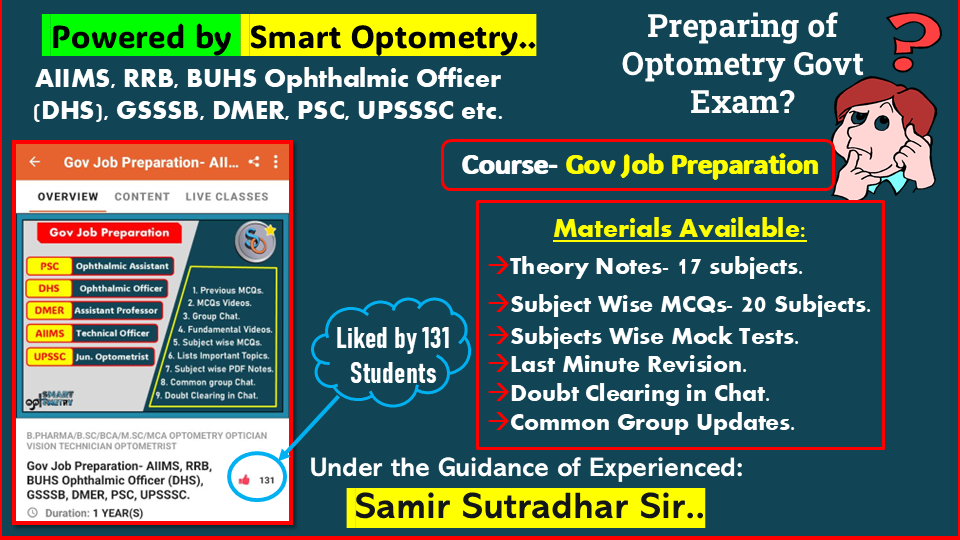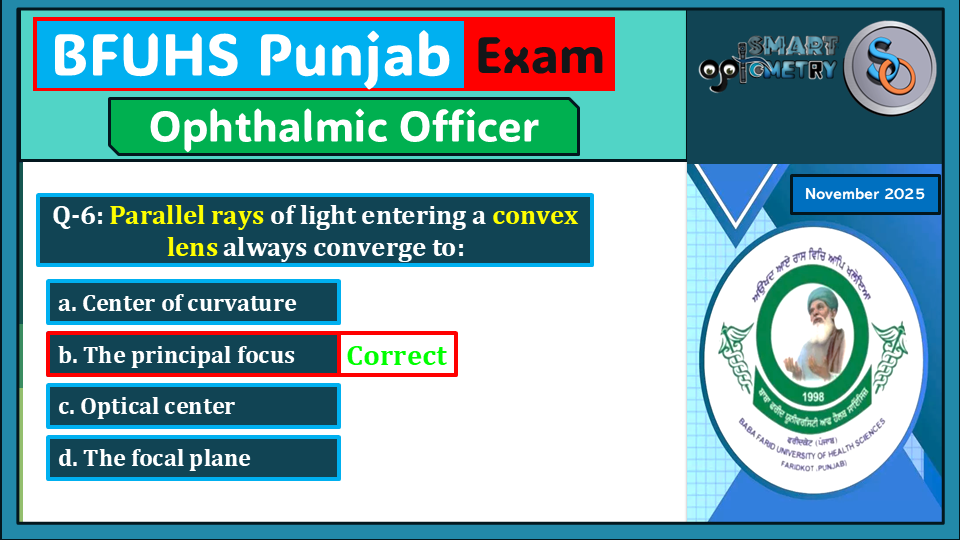Q-1: Irrespective of the etiology of the corneal ulcer, the drug always indicated is: (AIIMS Previous Year MCQs)
a. Corticosteroids
b. Cycloplegics
c. Antibiotics
d. Antifungals
Click “Show more” to see the answer and explanation.
The correct answer is B. Cycloplegics.
Explanation: Cycloplegics, such as atropine, are indicated in all corneal ulcers to relieve the pain caused by ciliary spasm. This paralysis of the ciliary muscle also helps prevent the formation of posterior synechiae.
Struggling with your optometry government job preparation? Let Samir Sir, the founder of Smart Optometry, guide you to success. Enroll in our “Gov Job Preparation” course, and we’ll provide the roadmap. Your dream job at GSSSB, AIIMS, RRB, or DHS is within reach!
.
.
Q-2: Timolol Maleate is one of the (AIIMS Previous Year Ocular Pharmacology MCQs)
a. Beta blocker drugs
b. Alpha-adrenergic agonists
c. Sympathomimetics
d. Cholinergic agents
Click “Show more” to see the answer and explanation.
The correct answer is A. Beta blocker drugs.
Explanation: Timolol Maleate is a non-selective beta-adrenergic antagonist, commonly known as a beta-blocker. It is used in glaucoma treatment to lower intraocular pressure by reducing the production of aqueous humor.
.
.
Q-3: Which of the following anti-glaucoma medications increases uveoscleral outflow? (AIIMS Previous Year MCQs)
a. Timolol
b. Dorzolamide
c. Mannitol
d. Latanoprost
Unlock your potential with our “Gov Job Preparation” course. Gain access to a massive library of 5000+ subject-wise MCQs, 1000+ previous year questions, detailed notes, and video lectures. Everything you need for exams like GSSSB, PSC, and DMER is in one place.
.
.
Q-4: Which type of solution provides quick, sustained, and durable antimicrobial activity? (AIIMS Previous Year Ocular Pharmacology MCQs)
a. Alcohol-based solutions
b. Chlorhexidine gluconate
c. Povidone-iodine (PVP-I)
d. Hydrogen peroxide
Click “Show more” to see the answer and explanation.
The correct answer is A. Alcohol-based solutions.
Explanation: Alcohol-based solutions provide rapid and broad-spectrum antimicrobial activity by denaturing proteins. Their effect is both immediate and sustained, making them highly effective for hand hygiene.
.
.
Q-5: Which of the following is not true of acute viral conjunctivitis? (AIIMS Previous Year MCQs)
a. Vision is not affected
b. Corneal infiltration is seen
c. Antibiotics are the mainstay of treatment
d. Pupil remains unaffected
Click “Show more” to see the answer and explanation.
The correct answer is C. Antibiotics are the mainstay of treatment.
Explanation: Acute viral conjunctivitis is a self-limiting infection, and antibiotics, which target bacteria, are not an effective treatment. Management is supportive, focused on relieving symptoms with cool compresses and artificial tears.
Prepare for a full year of opportunities! Our “Gov Job Preparation” course gives you 12 months of access to top-quality materials and support. Cover all major exams like GSSSB, AIIMS, RRB, Ophthalmic Officer without buying multiple courses. It’s the smartest investment for your career.
.
.
Q-6: A 36-year-old female develops pain in the eyes after a prone dark room test. Which of the drugs should be avoided? (AIIMS Previous Year Ocular Pharmacology MCQs)
a. Acetazolamide
b. Pilocarpine
c. Atropine
d. Timolol
Click “Show more” to see the answer and explanation.
The correct answer is C. Atropine.
Explanation: A prone dark room test assesses for angle-closure glaucoma, which is exacerbated by pupil dilation. Atropine is a strong mydriatic agent that would dilate the pupil, potentially triggering a painful acute angle-closure attack.
.
.
Q-7: Ocriplasmin is a recombinant protease used to treat: (AIIMS Previous Year MCQs)
a. Retinal break
b. Diabetic macular edema
c. Uveovitreal membrane
d. Submacular bleeding
Click “Show more” to see the answer and explanation.
The correct answer is C. Uveovitreal membrane.
Explanation: Ocriplasmin is a recombinant human protease that is used to treat symptomatic vitreomacular adhesion (VMA). It works by dissolving the protein matrix that connects the vitreous to the macula, thereby releasing the traction.
Don’t study alone! Our “Gov Job Preparation” course includes group chat and live support to clear all your doubts instantly. With guidance from Samir Sir and a community of fellow aspirants, you’ll stay motivated and on track.
.
.
Q-8: Concentration of tropicamide: (AIIMS Previous Year Ocular Pharmacology MCQs)
a. 0.01 (1%)
b. 0.02 (2%)
c. 0.03 (3%)
d. 0.04 (4%)
Click “Show more” to see the answer and explanation.
The correct answer is A. 0.01.
Explanation: Tropicamide is a fast-acting antimuscarinic drug that blocks the iris sphincter muscle, causing mydriasis . This effect is essential for allowing a wide, clear view of the fundus during an eye examination.
.
.
Q-9: Which of the following is used in the treatment of fungal keratomycosis? (AIIMS Previous Year MCQs)
a. Silver sulfadiazine
b. Linezolid
c. Vancomycin
d. Doxycycline
Click “Show more” to see the answer and explanation.
The correct answer is A. Silver sulfadiazine.
Explanation: Silver sulfadiazine is a topical sulfonamide antibiotic primarily used to prevent and treat bacterial infections in patients with severe burns. While it possesses some antifungal properties, it is not a standard first-line treatment for fungal keratomycosis.
.
Ready to secure your government job in optometry? The “Gov Job Preparation” course is your final destination. With a proven success strategy, expert mentorship, and over 6000 MCQs, we make your preparation seamless and effective. Click the link to begin your journey!
.
Q-10: Which of the following does not result in amorphous whorl-like deposits in the cornea? (AIIMS Previous Year MCQs)
a. Chloroquine
b. Amiodarone
c. Indomethacin
d. None of these
Click “Show more” to see the answer and explanation.
The correct answer is D. None of these.
Explanation: All three listed medications—Chloroquine, Amiodarone, and Indomethacin—are known to cause cornea verticillata. This condition is characterized by bilateral, whorl-like epithelial deposits that are typically benign and reversible upon drug cessation.
.
.
Q-11: Which of the following topical drugs causes heterochromia iridis? (AIIMS Previous Year MCQs)
a. Latanoprost
b. Prednisolone
c. Olopatadine
d. Timolol
Click “Show more” to see the answer and explanation.
The correct answer is A. Latanoprost.
Explanation: Latanoprost is a prostaglandin analogue that effectively lowers intraocular pressure by increasing uveoscleral outflow. A well-known side effect is increased iris pigmentation (heterochromia iridis), which is more common in individuals with light-colored or mixed-color irides.
Struggling with your optometry government job preparation? Let Samir Sir, the founder of Smart Optometry, guide you to success. Enroll in our “Gov Job Preparation” course, and we’ll provide the roadmap. Your dream job at GSSSB, AIIMS, RRB, or DHS is within reach!
.
.
Q-12: Cycloplegics are drugs that cause (AIIMS Previous Year MCQs)
a. Contraction of pupil
b. Dilation of pupil
c. Paralysis of ciliary muscles
d. Movement in ciliary muscles
Click “Show more” to see the answer and explanation.
The correct answer is C. Paralysis of ciliary muscles.
Explanation: Cycloplegic drugs are parasympatholytic agents that paralyze the ciliary muscle, thereby inhibiting accommodation. This paralysis results in the loss of ability to focus on near objects.
.
.
Prepare for a full year of opportunities! Our “Gov Job Preparation” course gives you 12 months of access to top-quality materials and support. Cover all major exams like GSSSB, AIIMS, RRB, Ophthalmic Officer without buying multiple courses. It’s the smartest investment for your career.
.
Are you preparing for the AIIMS Ophthalmic Assistant exam or other optometry government jobs? 🇮🇳 This blog breaks down the most important Ocular Pharmacology MCQs from previous AIIMS exam papers.
We will solve and explain each question in detail, helping you understand the core concepts needed to clear your exam. 🧑🏫 This blog is essential for any optometrist or optometry student targeting government jobs.
🎯 Enroll in Our “Gov Job Preparation” Course! 🎯
Get complete, structured preparation for all optometry government exams (AIIMS, RRB, DHS, GSSSB, DMER, etc.) on our app.
🔗 Course Link: https://osvlt.on-app.in/app/oc/624036/osvlt?utm_source%3Dcopy-link%26utm_medium%3Dtutor-course-referral%26utm_campaign%3Dcourse-overview-app
📚 Download Our App: “Optometry Notes and MCQs” 📚
Access mock tests, previous year papers, video lectures, and detailed notes.
🔗 App Link: https://play.google.com/store/apps/details?id=co.robin.osvlt
📝 In This Blog, We Cover:
This session focuses on key Ocular Pharmacology topics that frequently appear in AIIMS and other paramedical exams.
Topics Covered Include:
✅ Drugs for Corneal Ulcers (Cycloplegics)
✅ Beta-blockers (Timolol Maleate)
✅ Glaucoma Medications (Latanoprost & Uveoscleral Outflow)
✅ Antimicrobial Solutions
✅ Acute Viral Conjunctivitis Treatment
✅ Angle-Closure Glaucoma & Contraindicated Drugs (Atropine)
✅ Ocriplasmin & Vitreomacular Adhesion
✅ Mydriatics (Tropicamide)
✅ Fungal Keratomycosis Treatment
✅ Cornea Verticillata (Drug-Induced Deposits)
✅ Drug-Induced Heterochromia Iridis
This Blog is highly beneficial for aspirants of:
🧑⚕️ AIIMS Ophthalmic Assistant / Optometrist
🧑⚕️ Ophthalmic Officer (DHS, PSC)
🧑⚕️ GSSSB, DMER, UPSSSC Ophthalmic Officer
🧑⚕️ RRB Optometrist / Paramedical Exams
.
- Check Our Courses: Ophthalmic Instrumentation, Clinical Refraction, Contact Lens, Binocular Vision, Dispensing Optics, MCQs in Optometry
- Download our App “Optometry Notes & MCQs” from Google Play Store.
.




